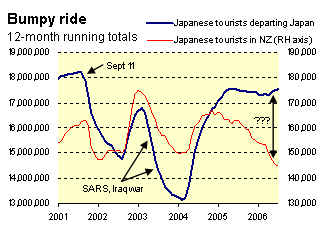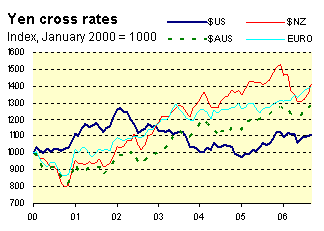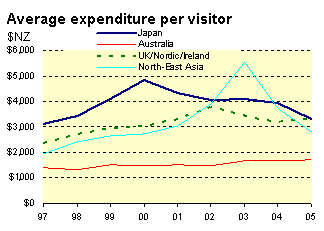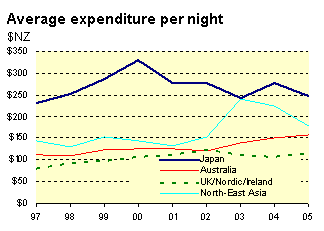The land of the setting sun
Japanese visitor arrival numbers to New Zealand have been declining steadily over the past 18 months. But unlike similar downturns over recent years which were driven by one-off global events (September 11, SARS, and the Iraq war), the falling numbers this time round do not have a single, easily identifiable cause. Moreover, the fall in the number of Japanese people visiting New Zealand comes at a time when the total number of Japanese holidaying abroad is beginning to rise. So why has New Zealand fallen out of favour with the Japanese? And is this really something the New Zealand tourism industry need be concerned about — won’t the burgeoning numbers of middle-class Chinese more than offset a decline in Japanese holidaymakers?
A drop in the bucket
Of the 17.4m Japanese tourists who travelled abroad in 2005, less than 1% (155,000) visited New Zealand. China was the destination of choice for 20% (3.4m) of Japanese travellers, while other close-to-home Asian countries South Korea (14%), Thailand (7%), and Taiwan (6.5%) were also popular. Europe and the US (Hawaii in particular) were the favourite long-haul destinations.
Japanese tourist arrivals in New Zealand peaked in the summer of 2002/03, when the 12-month running total exceeded 170,000. SARS and the Iraq war kept many Japanese at home over the remainder of 2003, but by the end of 2004 the annual total was back over 165,000. Since then, however, Japanese tourist numbers in New Zealand have fallen markedly, with the annual total hitting a 12-year low (141,300) by September 2006.
Worryingly for the local tourism industry, the rate of decline in Japanese travelling to New Zealand has far exceeded the slowdown in the total number of Japanese holidaying abroad. Indeed, the 13% annual fall in Japanese tourists in New Zealand over the September quarter this year comes at a time when the total number of Japanese holidaying abroad is beginning to rise, as the graph below shows.

So what happened to our mojo?
At a conference held on the Japanese market in May, Tourism New Zealand identified a number of factors that have contributed to the dwindling numbers of Japanese visitors:
Much of New Zealand’s loss of price competitiveness can be attributed to the sharp lift in the New Zealand dollar over the past six years. From a low of ¥43 in 2000 to its peak at ¥82 last year, the Kiwi strengthened an astonishing 90% against the yen, far outstripping the relative currency appreciations of other key long-haul competitor destinations. Coupled with a reduction in passenger seat numbers, the relative strength of the Kiwi made holidaying in New Zealand more expensive when compared to other countries. In 2004, package tours to New Zealand for Japanese travellers were up to 25% more expensive than those to Canada, Europe, Australia, or the US.

Golden goose
The Japanese market is important for two reasons. The first is its size. With approximately 130m inhabitants, the second largest economy in the world, high GDP per capita, and an aging population sitting on a mountain of cash, Japan ticks all the boxes in terms of tourism growth potential. Secondly, and perhaps more importantly, is the spendthrift nature of Japanese travellers. When measured on either an expenditure-per-visitor or an expenditure-per-night basis, the Japanese have consistently been in the top one or two nationalities over recent years (see graphs).

It is remarkable that expenditure per visitor for Japanese tourists is so high considering the brevity of their stay. At an average of 13.8 nights per visitor over 2004 and 2005, the length of stay for Japanese tourists was lower than that of their Chinese (18.4) and South Korean (14.7) neighbours, and is also shorter than that of the typical visitor from the US (the west coast of the States is a similar distance from New Zealand as Japan).

The money and the bag
With the Chinese economic juggernaut creating an increasingly wealthy and inquisitive middle class, it is certainly tempting for the tourism industry to lump future growth prospect hopes in the made-in-China basket. Indeed, the growth in Chinese visitor numbers in recent years has been impressive — arrivals have tripled from 33,500pa in 2000 to more than 100,000 pain September this year. And the numbers are set to grow further with the commencement of Air New Zealand’s direct service to Shanghai in November.
But while the Chinese market is of undoubted potential, its development ought not be at the expense of other already established markets, particularly the lucrative Japanese one. New Zealand is an established brand in Japan, the networks within the travel industry there have been well traversed, and local operators are attuned to the requirements of the Japanese market. With these structures already in place, the marginal benefit of any effort aimed at rejuvenating Japanese arrival numbers may well exceed the return to investment in less developed markets, at least in the short term.
A new dawn
Three critical drivers of tourism activity point to a turnaround in the Japanese market over the medium term:
1. The exchange rate: New Zealand dollar weakness over the next 12 months will alleviate pricing concerns, boosting per day spending as well as lifting arrival numbers.
2. Economic growth: The Japanese economy is finally waking from its slumber. The Japanese economy grew 2.6% in 2005, and is forecast to grow at comfortably above 2%pa this year and next.
3. Advertising: Tourism New Zealand has allocated an additional $4.5m to promoting New Zealand in Japan. The campaign will be a continuation of the existing 100% New Zealand promotion, but will place greater emphasis on the diversity of experiences New Zealand has to offer.
Further out, the Rugby World Cup in 2011 shapes as ideal opportunity for the tourism industry to raise New Zealand’s profile with the Japanese. While well behind baseball and football in terms of popularity, rugby is nevertheless widely followed in Japan, and with their national team likely to be present at the tournament, the event will receive broad coverage in the Japanese media.




